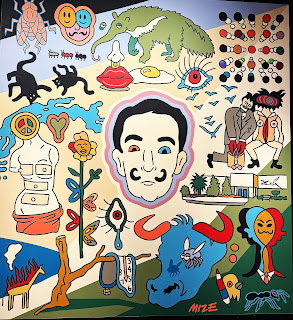 |
| Family Portrait II (1933) |
The Stettheimers were a wealthy Jewish family who were contemporaries of the Guggenheims and Morgenthaus in New York. They were intellectuals who traveled the world. Joseph abandoned his wife and five children when the kids were young. But Rosetta had family money of her own, so their luxurious lifestyle was not hindered by his absence.
 |
| Detail from Spring Sale at Bendels (1921) |
Florine also wrote poetry that had a tongue-in-cheek quality about it. (Her daring self-portrait styled after Manet's "Olympia" and Titian's "Venus of Urbino" did as well.)
 |
| A Model (Nude Self-Portrait) (1915) |
Our Parties
Our Picnics
Our Banquets
Our Friends
Have at last a raison d'etre
Seen in color and design
It amuses me
To recreate them
To paint them.
 |
| Costume for "Georgette" |
Now knowing a bit about who Florine Stettheimer was, I still wondered why I'd never heard of her. The exhibit description explained that Florine has frequently been considered "a lightweight feminine artist." But her lack of name recognition might also result from her low-key profile during her lifetime. Florine apparently intended her paintings and poetry be enjoyed primarily by family and friends. In fact, she had expressed a desire to have her work destroyed after her death. Luckily, her sister Ettie, who served as executor, ignored this wish.
For a more scholarly review of the show, read Roberta Smith's article in the New York Times by clicking here. (The article also includes more images of Stettheimer's vibrant artwork.)
Florine Stettheimer: Painting in Poetry will be on display at the Jewish Museum in New York through September 24th. It's an exhibit that you are sure to leave with a smile on your face.
.jpg)


No comments:
Post a Comment